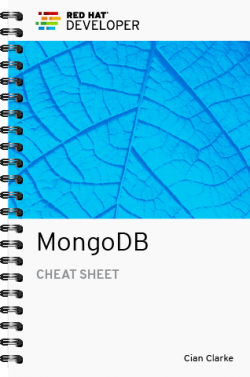- Mongodb Shell Cheat Sheet Excel
- Mongodb Shell Cheat Sheet Free
- Mongodb Query Language Cheat Sheet
- Mongodb Shell Find
- Mongodb Shell Cheat Sheet Pdf
- Cheat Sheet Terraria
- Mongo Shell Cheat Sheet Pdf
Introduction
In this Linux/Unix command line cheat sheet, you will learn: Basic Linux commands File Permission commands Environment Variables command User management commands of linux Networking command Process co. How to Write Shell Script in Linux/Unix. Shell Scripts are written using text editors. On your Linux system, open a text editor program, open a new file to begin typing a shell script or shell programming, then give the shell permission to execute your shell script and put your script at the location from where the shell can find it. File Management becomes easy if you know the right commands. Sometimes, commands are also referred as 'programs' since whenever you run a command, it's the corresponding program code, written for the command, which is being executed. Terraform commands cheat sheet Terraform Cloud Terraform 14 Creating Private TLS Certs Ansible 2.0 What is Ansible? Quick Preview - Setting up web servers with Nginx, configure environments, and deploy an App SSH connection & running commands Ansible: Playbook for Tomcat 9 on Ubuntu 18.04 systemd with AWS Modules Playbooks Handlers Roles.
If you’re just getting started with MongoDB or it’s been a while since you’ve used Mongo, you might need a reference for the most common MongoDB commands. This article will give a list of the most common tasks and the MongoDB command used to do execute it. Print it out, keep it on your desk, memorize it, we encourage you to do whatever you need to do get value out of this cheat sheet. Now after all it is a cheat sheet, so let’s get straight into it.
The Cheat Sheet

Start your MongoDB Daemon. You need Mongo running before you can run the Mongo Shell or interact with Mongo in any way.
Mongodb Shell Cheat Sheet Excel
mongod |
Start the MongoDB Shell. If you want to interact with Mongo through the command line this is how you’ll do it.
List all MongoDB databases. This is a good command to sanity check to just make sure all your databases are still there.
show dbs |
Create a database. Know that the database won’t actually be created until you insert a document until a collection.
Switch to another database. Using the Mongo Shell will default to using the test database so you’ll need to switch to your database or create your own.

use otherdb |
List all collections in database. Another good sanity check command to make sure your collections exist and are named exactly like you as you intended.
Create a collection.
db.createCollection('demoCollection') |
Insert a new document. You’ll run commands very similar to this all the time. Get used to it’s key-value pair syntax.
db.demoCollection.insert({'field1': 'value1', 'field1': 'value2'}) |
Get all documents in a collection. Super common command but if you have too many documents you’ll need to limit with conditions.
To get documents in a more readable format add .pretty() to the .find(). Add this on to all your find commands, as it’s basically unreadable without it.
db.demoCollection.find().pretty() |
Drop/delete a collection. Use this command and all drop/deletion commands with care. Guidance.
Show users.
show users |
Update a single document. Get familiar with $set and $push to update your documents.
db.demoCollection.update( { field1:'value1'}, { $set: { field2:'anotherValue' } } ) |
Update multiple documents. If you’re updating multiple documents at once through the shell use this or consider interacting with mongo through a higher-level language like python or javascript.
db.demoCollection.update( { field1:'value1'}, { $set: field2:'anotherValue'}, { multi:true } ) |
Conclusion
We reviewed a few of the basic commands including creating a database, creating a collection, and inserting a new document plus more. We hope this reference is useful to you as you learn MongoDB or as a reminder of some of the basic commands for MongoDB in the command line.
As we alluded to in the last command, if you find that you’re interacting with mongo through the console frequently you should consider using Python, Javascript, or another programming language to automate your tasks. Working with the console is essential sometimes and is highly regarded by developers, but you want to automate as much as possible and that is better done through these other languages.
Paragon ntfs for mac 15 rutracker. Thanks again for reading and don’t hesitate to reach out with any questions.
This article is about the default client for MongoDB: the MongoDB Mongo shell. In this article, we’ll:
Mongodb Shell Cheat Sheet Free
(This article is part of our MongoDB Guide. Use the right-hand menu to navigate.)
What is the MongoDB Mongo shell?
MongoDB Mongo shell is an interactive JavaScript interface that allows you to interact with MongoDB instances through the command line. The shell can be used for:
- Data manipulation
- Administrative operations such as maintenance of database instances
MongoDB Mongo shell features
MongoDB Mongo shell is the default client for the MongoDB database server. It’s a command-line interface (CLI), where the input and output are all console-based. The Mongo shell is a good tool to manipulate small sets of data.
Here are the top features that Mongo shell offers:
- Run all MongoDB queries from the Mongo shell.
- Manipulate data and perform administration operations.
- Mongo shell uses JavaScript and a related API to issue commands.
- See previous commands in the mongo shell with up and down arrow keys.
- View possible command completions using the tab button after partially entering a command.
- Print error messages, so you know what went wrong with your commands.
MongoDB has recently introduced a new mongo shell known as mongosh. It has some additional features, such as extensibility and embeddability—that is, the ability to use it inside other products such as VS Code.
Installing the mongo shell
The mongo shell gets installed when you install the MongoDB server. It is installed in the same location as the MongoDB server binary.
If you want to install it separately, you can visit the MongoDB download center, from there select the version and package you need, download the archive, and copy it to a location in your file system. Metabase superset.
Mongo shell is available for all main operating systems, including:
- Windows
- Linux
- Mac OS
Connect to MongoDB database
Once you’ve downloaded and installed MongoDB, you can use the mongo shell to connect with a MongoDB server that is up and running.
Note: It is required that your server is already running before you connect with it through the shell. You can start the server in CMD using the following command.
Then type mongo command to run the shell.
Now you are in the Mongo shell.
If you want, you can run the mongo and mongod without the command prompt. To do this, go to the installation location and double click on the mongod and mongo applications. You will get the same result as the above.
Different port
The above mongo command only works if your MongoDB server runs on the default port, which is 27017. If your MongoDB server runs on a different port, you have to explicitly specify it in the command, as shown below:
Remote server
Both of the above commands only work if your MongoDB server is running on the localhost. If you want to connect to a remote server, use the `–host` option with the mongo command, as shown below.
Basic commands for Mongo shell

Now it’s time to work with the Mongo shell. First, we will learn some basic commands that will help you to get started with using MongoDB.
Run the db command to see the database you are currently working with
Run the use command to switch to a different database. If you don’t have a database, learn how to create a new database.

You can create collections and insert data with the following command:
- db refers to the current database in use.
- employee is the collection name.
- insertOne is the method to insert a document to the collection.
Use the find method to fetch data in a collection. The forEach(printjson) method will print them with JSON formatting
Use the show dbs command to Show all databases
One important command will help you work with the Mongo shell easily: the help command. Run the help command to get a list of help options available in the mongo shell.
To get a full list of commands that you can execute on the current database, type db.help()
Mongodb Query Language Cheat Sheet
We will discuss more data manipulation commands in coming tutorials. For a full list of commands, check out the official Mongo shell page.
Mongo shell keyboard shortcuts
There are two important keyboard shortcuts that you should know:
- Use up and down arrows to go back and forth in the commands history.
- Press the tab key to get a full list of possible commands. For example, type d and press tab twice. You will get the following output.
Disadvantages of the mongo shell
Although the Mongo shell is an excellent tool for learning and testing the MongoDB server, it is difficult to be used in a production environment. Being a shell inherently carries certain disadvantages. Let’s see what they are:
Mongodb Shell Find
- The Mongo shell is strictly a console centric method of data manipulation. While some find it easy and quick, others might not find those characteristics appealing.
- If you are working on multiple sessions, you need multiple terminals.
- If the results are too long, they scroll away.
- Repetitive commands or debugging a function need the programmer to traverse the long command line history manually.
Alternatives to MongoDB mongo shell
So now you know the mongo shell has some disadvantages. At this point, you may want to know what other options are available. MongoDB developers have introduced drivers specific to each programming language to connect with the MongoDB databases when using MongoDB in your applications. You can find them here.
Additionally, many people prefer to use GUIs to work with databases nowadays. One of the best GUI tools for MongoDB is the MongoDB Compass. Some other useful GUI tools are:
Remember that the best MongoDB GUI depends on the task that needs to be accomplished. MongoDB Compass is the go-to option if you need to avoid the command line completely. Robo 3T is simple and well supported by the community, while NoSQLBooster is shell centric smart GUI tool.

Mongodb Shell Cheat Sheet Pdf
With that, we’ve reached the end of this tutorial. Now, play with the shell and get practice.
Cheat Sheet Terraria
Additional resources
For more tutorials like this, explore these resources:
Mongo Shell Cheat Sheet Pdf
- MongoDB Guide, a series of tutorials




